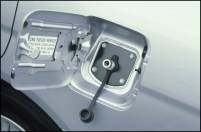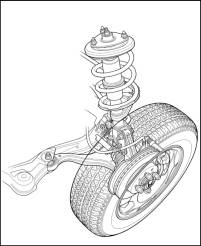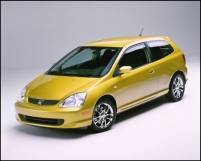The HX (available only in coupe form) came outfitted with a VTEC-E equipped Lean Burn 1.7-litre motor, and also had an available CVT transmission to increase fuel economy even more, netting between 5.3 and 5.9 L/100 km (40 and 44 miles per gallon). The GX sedan was the ultimate in fuel economy,
 |
| The natural gas powered GX model was the only other model besides the EX to benefit from ABS brakes. Natural gas's relatively low price makes the GX a cheap runabout. (Photo: Honda Canada) |
coming standard with the CVT and a 1.7L running on natural gas, earning it a the lowest emissions rating possible. And while the 7.8/6.9 L/100 km (30/34 mpg) rating doesn't sound astounding, the cheaper price of natural gas makes the GX a very cheap car to run. All other models are powered by 1.7L four cylinders producing 115 horsepower, with the exception of the GX, HX, and EX. The latter is the 2001 lineup's heavy hitter, producing 127 horsepower from a VTEC-equipped 1.7L, with the HX coming in second at 117 horsepower. On the other end of the spectrum, the clean burning GX makes do with a paltry 100 horsepower. Needless to say, all models return excellent gas mileage, with the thirstiest DX and LX sedans still netting at least 7.8 L/100 km (30 miles per gallon).
While Honda took a step forward with the quality of the interior and drivetrain over the previous car, they took a step backward with the suspension. All that new interior room had to come from somewhere, and it came from replacing the advanced double wishbone suspension in the
 |
| While Honda may have taken a step forward with the powertrain and interior accoutrements of the seventh-generation Civic, the loss of the sophisticated double-wishbone front suspension (replaced with a more compact and pedestrian MacPherson strut system) upset many enthusiasts. (Photo: Honda Canada) |
front with a more compact and lower-performing MacPherson strut setup. This also allowed them to move the motor forward in the car, extending leg room from the passenger and driver. Thankfully, the double wishbone rear suspension is retained, however, even it loses its trailing arms in favour of a flat rear floor section. Finally, spring and damper tuning rates were adjusted to give a softer, more comfortable ride, dissolving some of the Civic's famous go-kart like handling feel in the name of commuter comfort. Until the following year that is.
To ring in 2002, Honda brought back the Si badge (in the U.S., SiR badge in Canada), and with it all the estranged performance enthusiasts that had scoffed at the new Civic's lack of performance. Beginning with a new hatchback body style, Honda then stuffed an Acura RSX 2.0L VTEC-equipped motor under the hood, infusing the SiR with a healthy 160 horsepower. To handle this increase in power, the suspension was worked over, with the damping and spring rates cranked back up to levels similar to those found in the European Honda Civic Type R, which is to say the ride was "sporting." The whole car
 |
| Honda's Civic SiR tried to bring disillusioned performance enthusiasts back into the Honda fold with a unique body style and an Acura-sourced 2.0L VTEC-equipped motor churning out 160 horsepower. (Photo: Honda Canada) |
was stiffer than the average Civic as well, with the cross-section members and floor section beefed up to handle the additional loads brought on by high speed cornering. Also, ABS and rear disc brakes came standard on the SiR, as did the nifty dashboard-mounted, rally-inspired 5-speed shifter. And finally, Honda finished off the SiR with all the EX-level goodies, and built it in Great Britain, as opposed to the other models that were constructed in the U.S., Canada, or Japan. Of course, along with all this performance, the SiR also carried a heftier price tag, and still demand higher prices than other models, even though it was the least fuel efficient, burning a gallon of gas every 26 miles in the city - the equivalent of 9.0 L/100 km.







